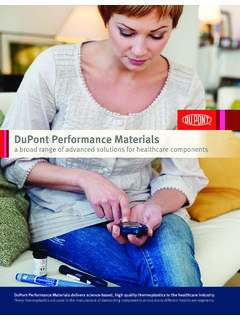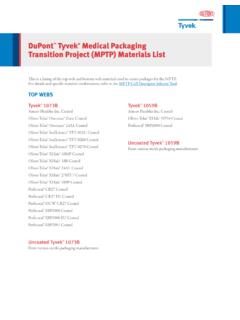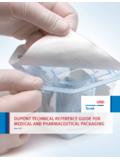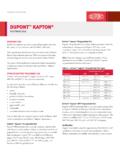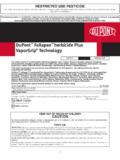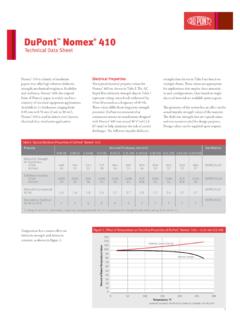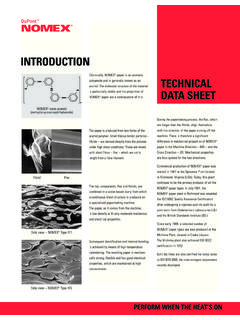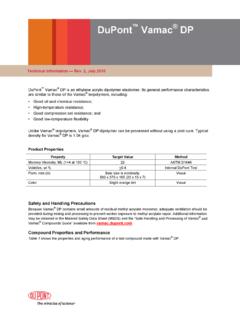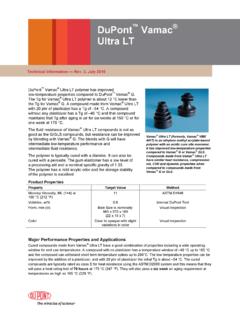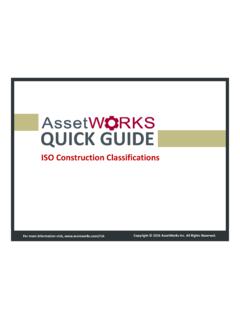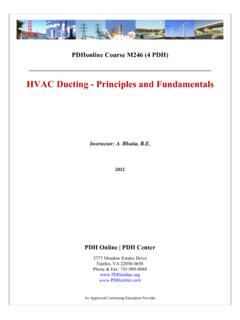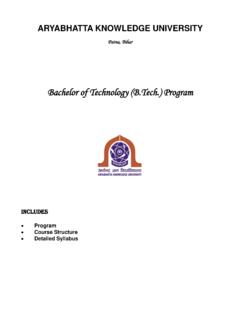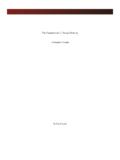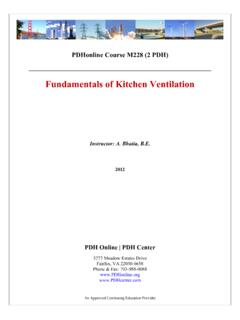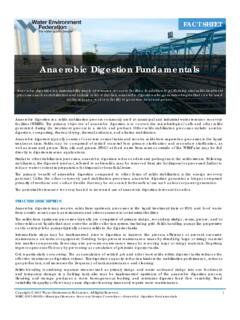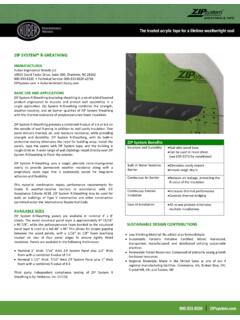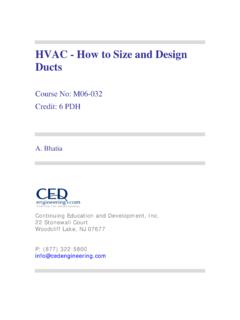Transcription of DuPont Thermax Sheathing
1 DuPont Thermax Sheathing Nonstructural, Glass-Fiber-Infused Rigid Polyiso InsulationProduct Information SheetFEATURES/BENEFITSD escriptionDuPont Thermax Sheathing is a non-structural, rigid board insulation consisting of a glass-fiber-infused polyisocyanurate foam core laminated between 1 mil smooth, reflective aluminum facers on both sides. The glass-fiber reinforcement contributes to improved fire performance and dimensional stability. Thermax Sheathing also offers high, long-term thermal resistance, with facers that help prevent water and water vapor intrusion into the insulation foam allowing it to stabilize at a higher R-value.
2 In the USA, Thermax Sheathing can even be installed exposed to the interior without a thermal barrier. Used in conjunction with the appropriate joint closure system for the application, Thermax Sheathing with its low perm rating can help to reduce moisture condensation within and behind the insulation. Ease of Installation Thermax Sheathing : Separate membrane or housewrap not needed if used with appropriate joint closure system Can be installed on walls and ceilings while exposed to the interior without any thermal barrier Contains UV-stable technology can remain uncovered up to six months Helps reduce the potential for condensation within the wall assembly Is lightweight easy to cut, handle and installAvailable SizesSizes, R-values and edge treatment options for Thermax Sheathing can be found in Table 1.
3 Contact your local sales representative for additional 1: Sizes(1), R-Values(2)(3)(4) And Edge Treatments For Thermax Sheathing Nominal Board Thickness (in.)Thermal Properties*Board Size AvailabilityEdge TreatmentUS (in)Canada (mm)R-ValueLTTR m2* C/W CanadaUS (ft)Canada (mm) * *4 x 8*Square * *4 x 8*Square x 81220 x 2440 Square Edge1* **4 x 8*Square * *4 x 8*Square * *4 x 8*Square Edge, * *4 x 8*Square x 81220 x 2440 Square **4 x 81220 x 2440 Square Edge, *16*4 x 8*Square Edge, Shiplap3 **4 x 81220 x 2440 Square Edge, *22*4 x 8*Square Edge4*25*4 x 8*Square Edge, ShiplapSustainable SolutionsThermax Sheathing is manufactured from 100% renewable power and has a zero ozone depleting potential and negligible global warming potential.
4 The use of Thermax Sheathing helps reduce the carbon footprint of commercial buildings and can contribute to LEED Credits. California Department of Public Health (CDPH) VOC emissions compliant.[1] Contact your DuPont seller for information at different R-values and other sizes and lead time requirements. Not all product sizes are available in all regions.[2] Thermax Brand insulation has a higher R-Value at lower temperatures. At 40 F mean temperature and 1 board thickness, R-Value is , and for 2 board thickness, R-Value is 14.
5 [3] Additional reflective R-Value can be claimed when the air space is at least and in conformance with requirements in ASHRAE Fundamentals Handbook.[4] Conditioned thermal values were determined by ASTM C518 at 75 F mean temperature. Test specimens were conditioned in accordance with procedures outlined in ASTM C1289, Section * Product not available in Canada. ** See CCMC 08433-L for thermal values assessed by the CCMCTABLE 2: Physical Properties of Thermax Sheathing PropertiesUS (per ASTM C1289)Canadian (per CAN/ULC S704)Test MethodValuesTest MethodValuesCompressive Strength(1)ASTM D162125 psi minASTM D1621170 kPaFlexural StrengthASTM C20340 psi minASTM C203275 kPa minThermal Resistance (LTTR)ASTM C518(see table)
6 CAN/ULC m2* C/W at 50 mmTensile Strength ASTM D162324 psi D1623134 kPa minDimensional StabilityASTM maxASTM maxWater AbsorptionASTM maxASTM maxWater Vapor TransmissionASTM E96< permASTM E96 ng/Pa-s-m2 Surface Burning Characteristics(2), for both foam core and finished product Flame SpreadSmoke DevelopedASTM E84 Class A25<450 CAN/ULC-S102 2901301 Vertical compressive strength is measured at 10 percent deformation or at yield, whichever occurs Calculated flammability values for this or any other material are not intended to represent hazards that may be present under actual fire Standards Thermax Sheathing meets ASTM C1289 Standard Specification for Faced Rigid Cellular Polyisocyanurate Thermal Insulation Board, Type I.
7 Class 2 and CAN/ ULC S704-11. Applicable standards include: C203 Standard Test Methods for Breaking Load and Flexural Properties of Block-Type Thermal Insulation C209 Tensile Strength Perpendicular to Board Surface C518 Standard Test Method for Steady- State Thermal Transmission Properties by Means of the Heat Flow Meter Apparatus D1621 Standard Test Method for Compressive Properties of Rigid Cellular Plastics D2126 Standard Test Method for Response of Rigid Cellular Plastics to Thermal and Humid Aging D2842 Standard Test Method for Water Absorption of Rigid
8 Cellular Plastics E96 Standard Test Method for Water Vapor Transmission of Materials D1623 - Standard Test Method for Tensile and Tensile Adhesion Properties of Rigid Cellular Plastics CAN/ULC-S770 Standard Test Method for Determination of Long-term Thermal Resistance of Closed-Cell Thermal Insulating Foams CAN/ULC-102 Method of Test for Surface Burning Characteristics of building Materials and AssembliesNoticeThermax Sheathing complies with the following codes: ASTM E2178 Standard Test Method for Air Permeance of building Materials leakage rates less than L/s/m2 at a test pressure of 75 Pa.
9 ASTM E2357 Standard Test Method for Determining Air Leakage of Air Barrier Assemblies ASTM E331 Standard Test Method for Water Penetration of Exterior Windows, Skylights, Doors, and Curtain Walls by Uniform Static Air Pressure Difference 2021, 2018, 2015, 2012, and 2009 International Residential Code (IRC) Section 316 2021, 2018, 2015, 2012, and 2009 International building Code (IBC) Section 2603 2021, 2018, 2015, 2012 International Green construction Code 2019 California Green building Standards Code 2020 ICC 700 National Green building Standard CAN/ULC S704-11 Type 3, Class 1 CCMC listing 08433-L FM 4880 Wall construction Metal-Faced Class 1 Fire Rated to Max.
10 30 Exposure High, Thick, 4 Wide, When Installed as Described in the Current Edition of FMRC Approval Guide. Contact DuPont Technical Support for most current FM 4880 attachment requirements. Intertek CCRR-0435 PROPERTIESDuPont Thermax Sheathing exhibits physical properties as indicated in Table 2 when tested as represented. Review all instructions and ( material ) Safety Data Sheet ((M)SDS) before use. Please contact DuPont at 1-833-338-7668 when additional guidance is required for writing specifications that include this product.
